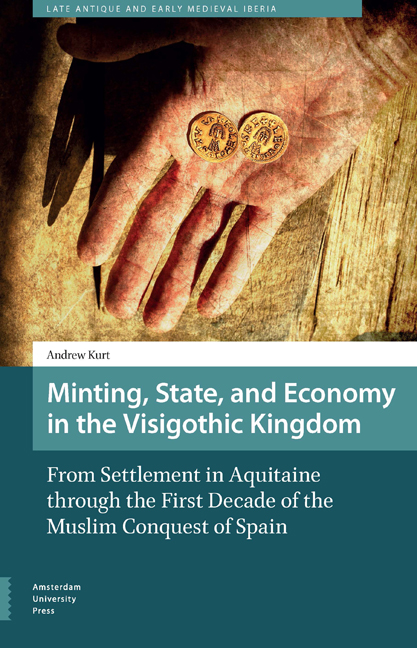 Minting, State, and Economy in the Visigothic Kingdom
Minting, State, and Economy in the Visigothic Kingdom Book contents
- Frontmatter
- Contents
- List of figures
- Acknowledgments
- Introduction
- 1 Pre-Regal Visigothic Coinage
- 2 The King’s Coinage: The Beginning and Development of theRegal Coinage (c. 573-c. 720) 81 A The Transition to a Regal
- 3 The Activities of the Mints from c. 573- c. 720
- 4 Why Were Gold Coins Struck in the Visigothic Kingdom?
- 5 The Royal Control of Visigothic Minting
- 6 Coinage in Spain in the Aftermath of the Islamic Conquest
- 7 Visigothic Currency in the Early Medieval Economy
- Conclusion
- Appendix I
- Appendix II
- Bibliography
- About the Author
- Index
2 - The King’s Coinage: The Beginning and Development of theRegal Coinage (c. 573-c. 720) 81 A The Transition to a Regal
Published online by Cambridge University Press: 21 November 2020
- Frontmatter
- Contents
- List of figures
- Acknowledgments
- Introduction
- 1 Pre-Regal Visigothic Coinage
- 2 The King’s Coinage: The Beginning and Development of theRegal Coinage (c. 573-c. 720) 81 A The Transition to a Regal
- 3 The Activities of the Mints from c. 573- c. 720
- 4 Why Were Gold Coins Struck in the Visigothic Kingdom?
- 5 The Royal Control of Visigothic Minting
- 6 Coinage in Spain in the Aftermath of the Islamic Conquest
- 7 Visigothic Currency in the Early Medieval Economy
- Conclusion
- Appendix I
- Appendix II
- Bibliography
- About the Author
- Index
Summary
Abstract
Chapter Two analyses the transition from a pseudo-imperial coinage to an overtly Visigothic regal coinage under Leovigild. The chapter proposes a chronology of the various steps of that significant evolution, taking into account key stages in Leovigild's reign including the rebellion of his son, Hermenegild. As the tremissis became the sole gold currency, intensified manipulation of standards and values developed alongside growing appreciation of the propagandizing use of minting, which frequently had a strong association with military operations. The chapter examines an apparently experimental period of silver coinage and a much more abundant bronze currency in certain areas, possibly emitted under the authority of municipalities or the Church. Copper-based currency brought parts of Spain in step with other Mediterranean regions.
Keywords: Kingdom of Toledo; VPW type; regal coinage; tremissis; Leovigild; copper
The Transition to a Regal Coinage
The currency of Visigothic Spain, like other currencies, reflects the political circumstances of the period. We have seen in the first chapter that for much of the sixth century Visigothic coinage was modeled on imperial coinage in its type and inscription, although in some ways it significantly diverged from its model. Both solidi and tremisses were struck according to Byzantine practice. Centers of coin production were probably few, although their number was increasing. Numerous finds of foreign coins in Iberia and abundant evidence of the circulation of Visigothic gold pieces throughout France show the integration of the currency with that of other kingdoms in a large area of monetary exchange. All of these facts show that the pseudo-imperial coinage did not have a ‘national’ character, one that was markedly Visigothic in its design and its usage. The reason is that the Goths did not yet have true dominion in Iberia in the first three quarters of the century. Only parts of Spain were firmly in the Goths’ control and, with the exception of Theudis, the kings of this period had a tenuous hold on power. Theses decades saw rivalries among Visigothic noblemen, assassinations of kings, a Byzantine invasion in the middle of the century, and rebellions in northern and southern Iberia. Northwestern Spain was in the hands of the Sueves, rivals whom the Goths could not completely overcome and who were under the influence of Francia and possibly Byzantium.
- Type
- Chapter
- Information
- Minting, State, and Economy in the Visigothic KingdomFrom Settlement in Aquitaine through the First Decade of the Muslim Conquest of Spain, pp. 81 - 122Publisher: Amsterdam University PressPrint publication year: 2020


